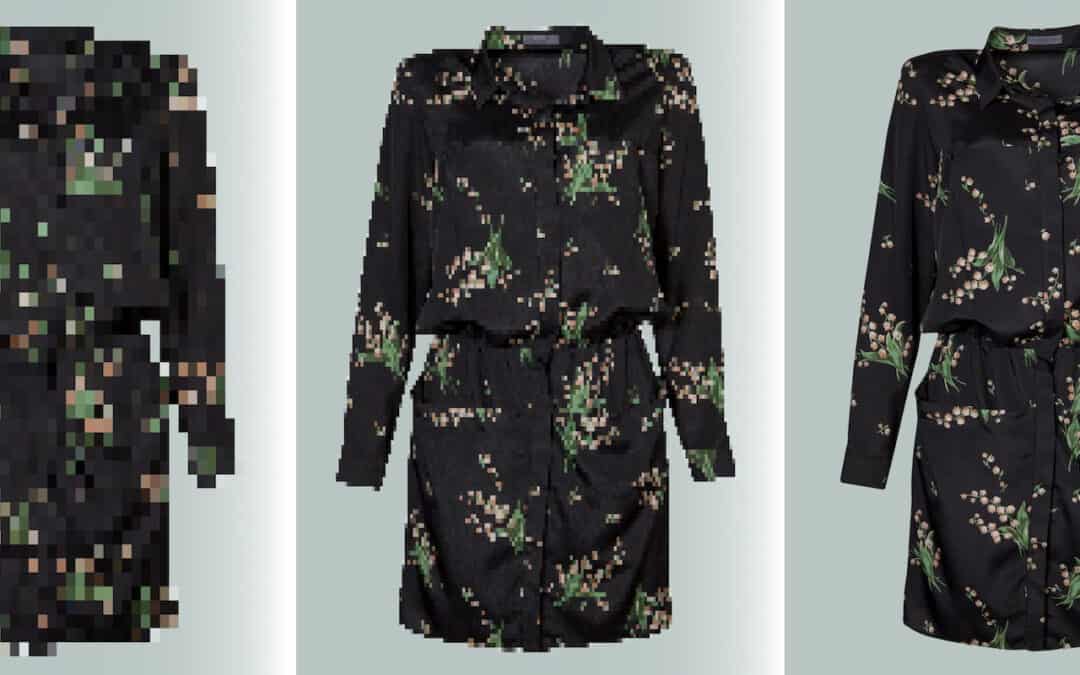When it comes to advertising your products, following Google Shopping and Facebook’s image requirements can make all the difference to convert shoppers into customers.
In 2019, Think With Google did a study in the U.S. where 50% of online shoppers said that images helped them decide what to buy.
On these platforms, the image is the largest part of the ad and the first impression users see before the title text and price tag. In some cases, eCommerce merchants take the product images from their website and re-use them for advertising purposes. This approach isn’t ideal because each ad type and platform have different image requirements.
In this post, you’ll learn how sizing file type, URLs, background, text, color, and many other factors play an important part in getting your ad images approved.
Also, you’ll have tips on how to troubleshoot disapproved images to get your campaigns back up and running, by improving your Facebook and Google Ads image optimization to get more converting customers.
Google Shopping Image Requirements & Optimization Tips For GMC Approval
Many advertising platforms have requirements. Google Merchant Center has especially complex and frustrating rules to deal with that constantly keep changing.
Each product you advertise has to abide by strict product data guidelines related to its structure and content within your product feed.
Image requirements are fairly straight forward but failing to comply leads to an automatic error on your account until the problem is fixed.
On the bright side, the image requirement documentation is very detailed and easy to follow, as noted below:
Google Shopping Image Requirements
- Clutter: Keep your images clean. If there’s too much going on, it can be difficult to determine what you’re trying to buy. The same rule applies to watermarks.
- Crawling: Images must be crawled fully before the product can be approved. The server may take extra time to finish this process, or certain images can take a few days to finish crawling.
- Format: Google accepts several different image formats: JPEG, PNG, BMP, TIFF, and non-animated GIFs.
- Placeholders: Placeholder images are banned unless you are selling paint (where single-color pictures are allowed) or when selling hardware or vehicle parts (where illustrations can be used).
- Size: The minimum size is 100 x 100 pixels, though apparel listings must be at least 250 x 250. The maximum size is 64 megapixels in both cases, and overall the image file itself must not be larger than 16 MB.
- Text: Google bans the addition of overlay text on images, as any text belongs in the description.
- URL: The Google algorithm requires a certain structure for image URLs. They have to link to the primary image of the listing, start with “HTTP” or “HTTPS,” and comply with RFC 2396 or RFC 1738 guidelines. For instance, quotation marks become “%22” and spaces would render out as “%20.” Broken links are not permitted.
Remember: the image must accurately portray what you’re selling. Inaccurate or generic images are frustrating to consumers and mess up Google’s algorithm.
To further improve the performance of your shopping campaigns, check out the full list of Google Shopping ads image requirements.

To convert more customers and divert attention away from competitors, you need to optimize the images you use. Here are a few actionable tips to help attract more shoppers:
Google Shopping Image Optimizations
- Make sure visitors know exactly what you’re trying to sell
Use high-quality images at decently high resolutions with good lighting. Move the camera at multiple angles.
Make sure the pictures are accurate to the actual product so that they match the color, dimensions, and other attributes. - Don’t be afraid to post more than one image
Whether it’s at a different zoom level or camera angle, it’s more appealing to be able to see the item from multiple images. - Use the power of editing
Some image editing programs are available to help touch up your pictures before posting them online.
Experiment with different effects and backgrounds, but don’t overdo it. Remember: you don’t want to divert attention away from the product itself. - Show the product in use
For certain categories of products like clothing, show off a model wearing the item outdoors or in another way. - Test your results regularly
A/B testing is a valuable asset in web design, and selling online is no exception. Regular testing ensures that you will find the ideal images to post on your Google Shopping account.
Note: Some of these tips aren’t necessarily required by Google, but they can still help give that extra push needed to attract visitors and improve conversions.
Google Shopping Images are not displaying: How to Fix Them
What happens when some of your images are disapproved or not displaying? Take a moment to review the guidelines and remember to:
- Find out why you’ve been disproved: The site will often give you a reason as to why the approval was rejected so that your business can fix the issue.
- Make a checklist: It should show the requirements pointed out earlier and go through the list to see whether any rules have been broken.
- Use automatic improvements: Google offers an automatic image checker to fix and replace certain pictures.
- Request a manual review if you are unable to find the problem yourself. Google Shopping has this feature in some cases but uses it sparingly as it takes up to 7 days.
There are so many factors that can cause disapproval, and it can be frustrating and challenging to diagnose every issue.
Consulting with a feed management partner can help you with image optimizations or any other aspect of listing your products on Google Shopping.
Dynamic Product Ads Image Requirements & Optimizations
Facebook Dynamic Product Ads appear either in the feed itself, in the right column, or in the marketplace. These three locations have different image requirements related to the number of images required, sizing and ratio. The optimizations for your images can also be affected by the location and ad type but there are also more general optimizations you can make to improve CTR.
Find out what Facebook Ads image requirements you need to optimize your images for better campaign performance:
Dynamic Product Ads Image Requirements
- Carousel ads: This setup requires at least two images and at most 5 on desktop and 30 on mobile. Images must be square and be a minimum of 400 x 400 with 500 x 500 as the standard recommendation.
- Collections: The image must be in a 1.91:1 ratio, and a size of 1200 x 628 is recommended.
- Image size: Single image ads must have a ratio of 1.91:1. Size must be at least 400 x 400 pixels, but 500 x 500 is recommended.
For the text in the Ad’s copy, use the following suggested numbers:
- Text: 125 characters for a single image or a carousel and 90 for a collection.
- Headline: 25 characters for a single image, 40 for a carousel, and 25 for a collection.
- Description: 30 characters for a single image and 20 for a carousel.
In addition to these technical requirements, here are some best practices you can follow to better optimize your images.
Dynamic Product Ads Image Optimizations
- Use images with a white backdrop: You want your products to stand out in the ad.
- Add multiple images of the product: If you plan to run carousel ads with the slideshow option or to sell the product in your shop Facebook recommends four or more images.
- Include a mix of images: Show the product from different angles, including close-ups of texture or details.
- Don’t include text that overlays the product, calls to action, promo codes, watermarks, or time-sensitive information like temporary price drops.
- Match the product images for the same product on your website.
- Form a color contrast: Facebook’s theme colors are blue and white. Choose contrasting colors to make your advertisement “pop” and stand out.
- Touch up everything: Whether it’s better lighting, more angles, or some editing tweaks in the post, take the time to make your images attractive. Take more pictures than you need initially so that you have plenty of material to work with.
- Don’t be afraid to see what competitors are doing: Are you stuck or have creative writer’s block? Do some research on what everyone else is doing. Don’t copy everything, but give yourself some ideas on which to base your business decisions.
Does it all sound too time-consuming for you? Getting the most out of Facebook marketing requires putting in the time.
However, similar to Google Shopping ads, there are automated product feed tools that can streamline these processes for you.
Troubleshoot Missing or Invalid Images
Troubleshooting Facebook Dynamic Product Ads, especially if you have a large catalog, can be extremely labor-intensive.
Facebook notifies you of issues with the ads in their Ads Manager under the Delivery column but it’s not always evident what the reason is for the disapproval.
An amber triangle denotes a warning, whereas a red one denotes an error. Errors need to be fixed immediately as they may be preventing your products from being approved. On the other hand, warnings need to be taken seriously too, as they can quickly turn into errors depending on what the issue is.
Here is how to fix common errors that can occur within Facebook Dynamic Product Ads:
Invalid Images
Pictures are commonly the culprit in the Facebook marketplace. Much like with Google Shopping images, check the size, dimensions, format, and URL of each picture. Ensure that the Facebook Crawler can properly scan through your pictures.
Inactive Products
Some items may be marked as “archived,” “out of stock,” or “expired.” Make sure all items are active (which may take up to 48 hours to reflect in the live site) and available.
Against Facebook TOS
Double-check the advertising policies on Facebook. Rejected items can be found on your Commerce Manager, where you can also find tips on how to repost the listings. Sellers also have the option to request an official review from Facebook staff.
How to Streamline Your Google and Facebook Ad Campaigns

No matter where you choose to sell—Facebook, Google, or some combination of both—getting the details right is essential if you want to maximize your chance of converting customers.
A Product Feed Management Solution designed specifically for shopping campaigns on Facebook and Google can help you expand your product sales with the help of a managed service and centralized dashboard for all of your advertising channels.
Find out why top brands like Vans, The North Face, Falconeri, Signorvino, and Prada trust us to optimize and manage their online shopping feeds. Book a demo of Highstret.io SaaS platform and get the help you need with Image Optimization for better Campaigns on Google Shopping and Facebook.

